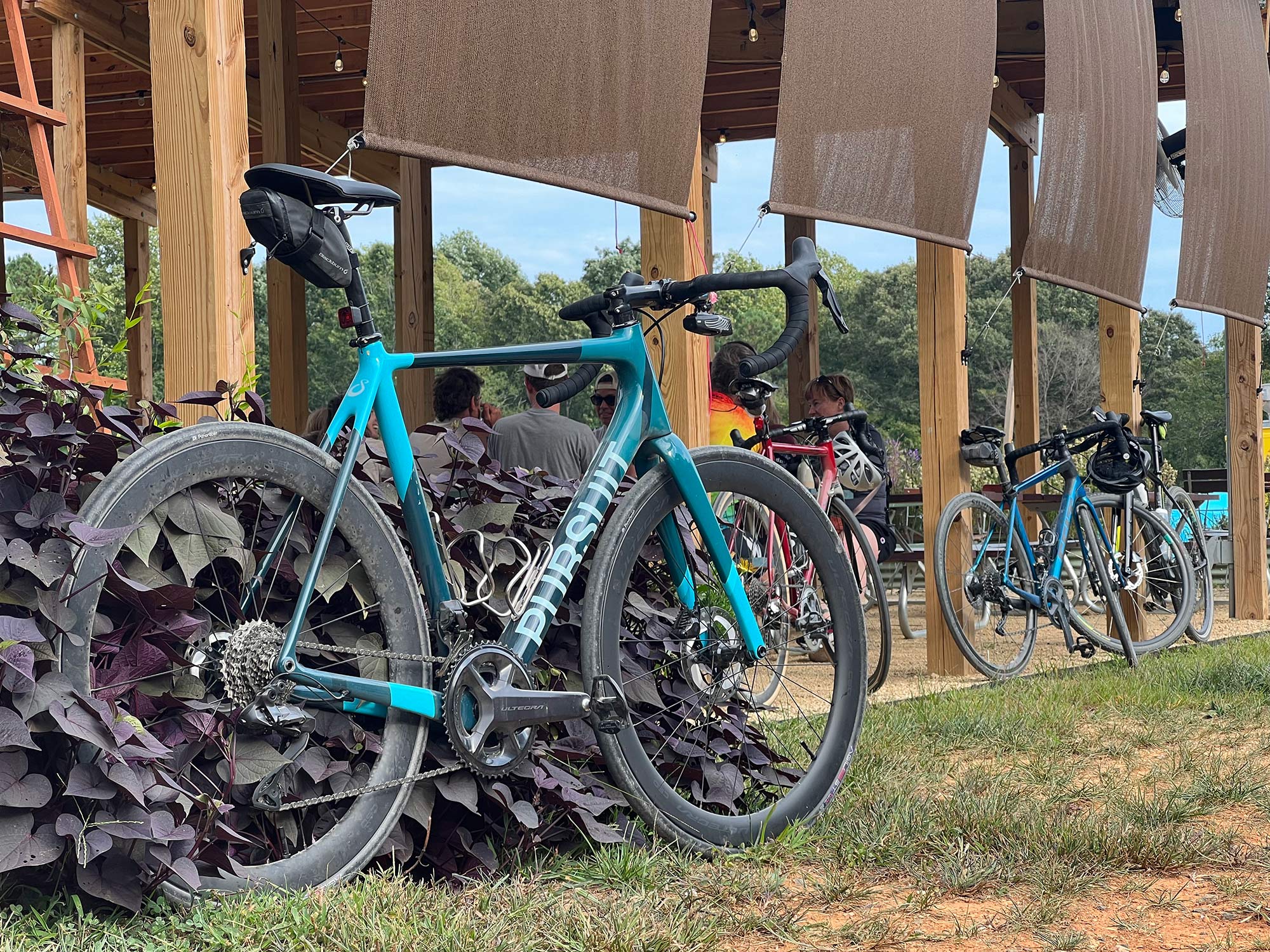Shimano’s entry into the 12-speed road drivetrain category came a bit later than their competition, but they made up for it with stellar performance and long-term durability.
I’ve been riding the group for nearly two years and it continues to provide flawless shifting, smooth operation, and quiet rolling. Even the wheels, which never seem to get as much attention, are great. Here’s my long-term review…
Setup & Install Notes

I installed the Ultegra group on a Pursuit Allroad, an excellent bike that made my 2022 Editor’s Choice list. Everything went as it should with one catch that’s important to note if you’re installing it yourself, and this includes shop folks… make sure to use the correct spacers on the BB spindle.
Before you read the next five paragraphs, know that I’m not knocking anyone. This is a simple mistake that anyone can make, and it caused a lot of head-scratching grief. Shimano installed the group in their SoCal HQ and commented about how front shifting seemed off. The front derailleur couldn’t move the chain far enough down to reliably shift onto the small chainring.
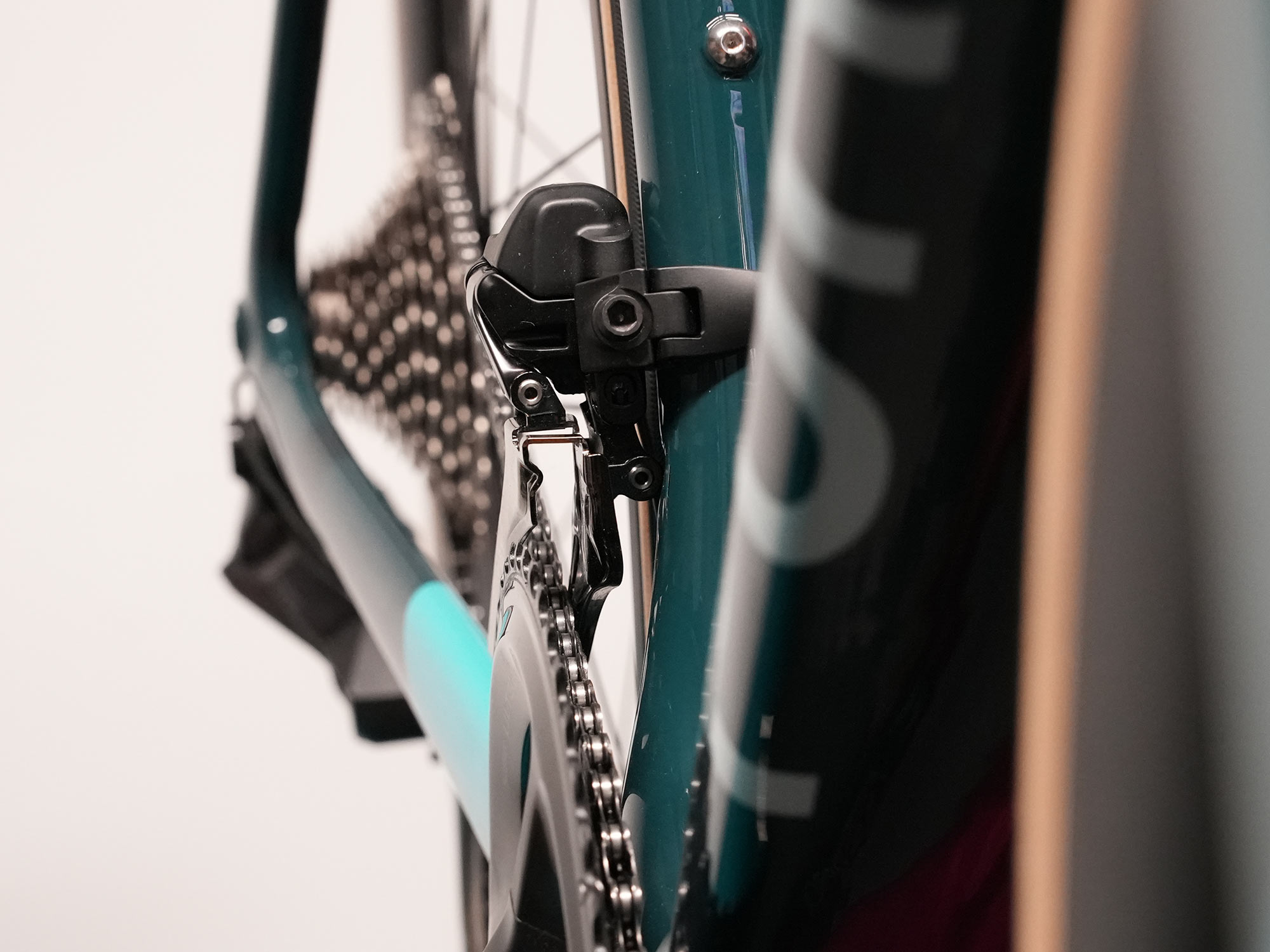
So they sent it back to Pursuit thinking that it was a frame tolerance issue. Carl Strong, co-founder of Pursuit and amazing frame builder, checked, re-checked, and confirmed the frame was exactly to spec.
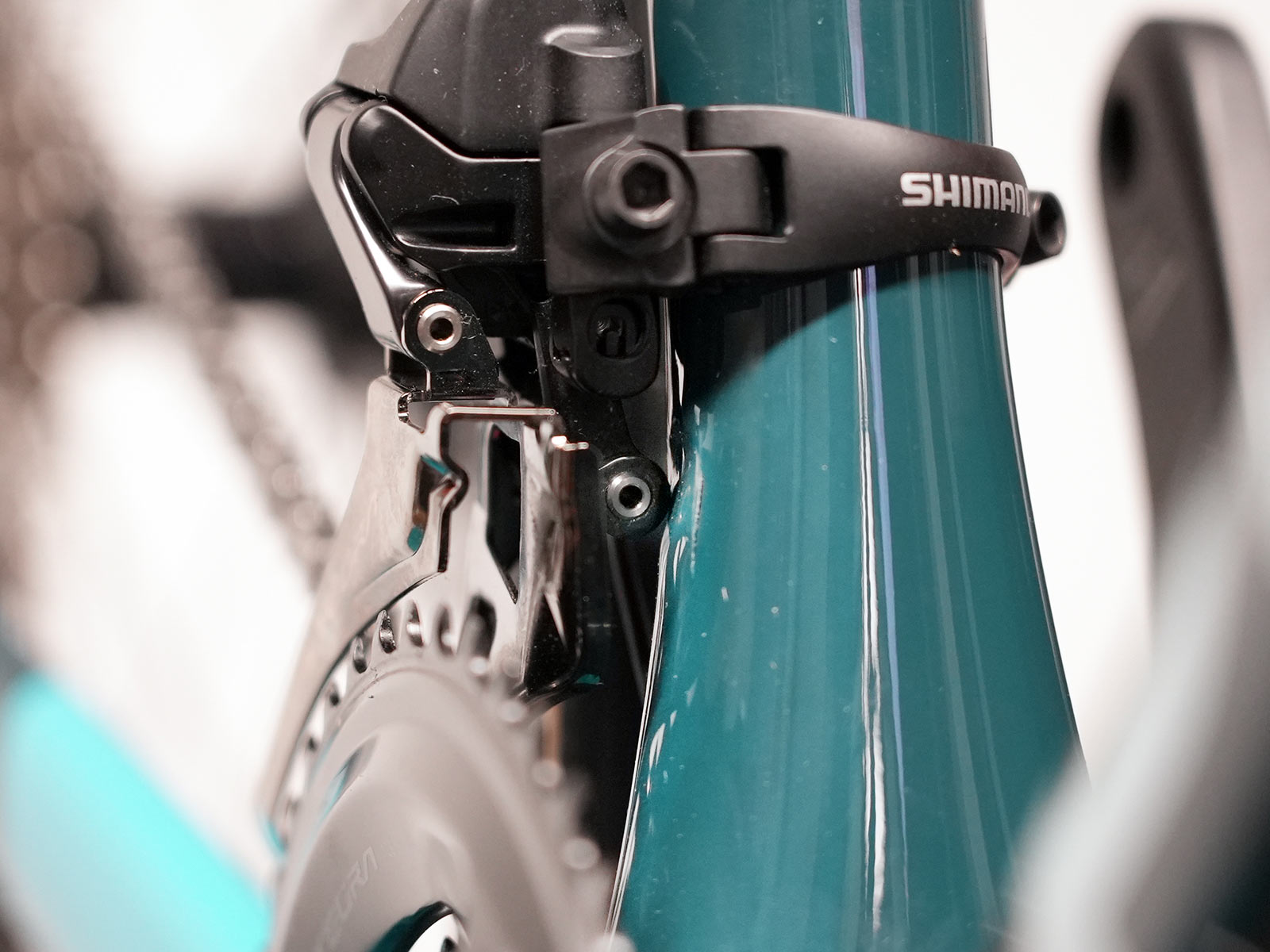
Even so, he heated and molded a small divot into the downtube to add clearance for the front derailleur’s cage pivot, and that helped, but didn’t entirely fix it.
I received the bike and had the local Shimano rep visit to replace the front derailleur, thinking maybe that was the issue, and then re-check everything. The new part was identical to the original, and that wasn’t the problem.
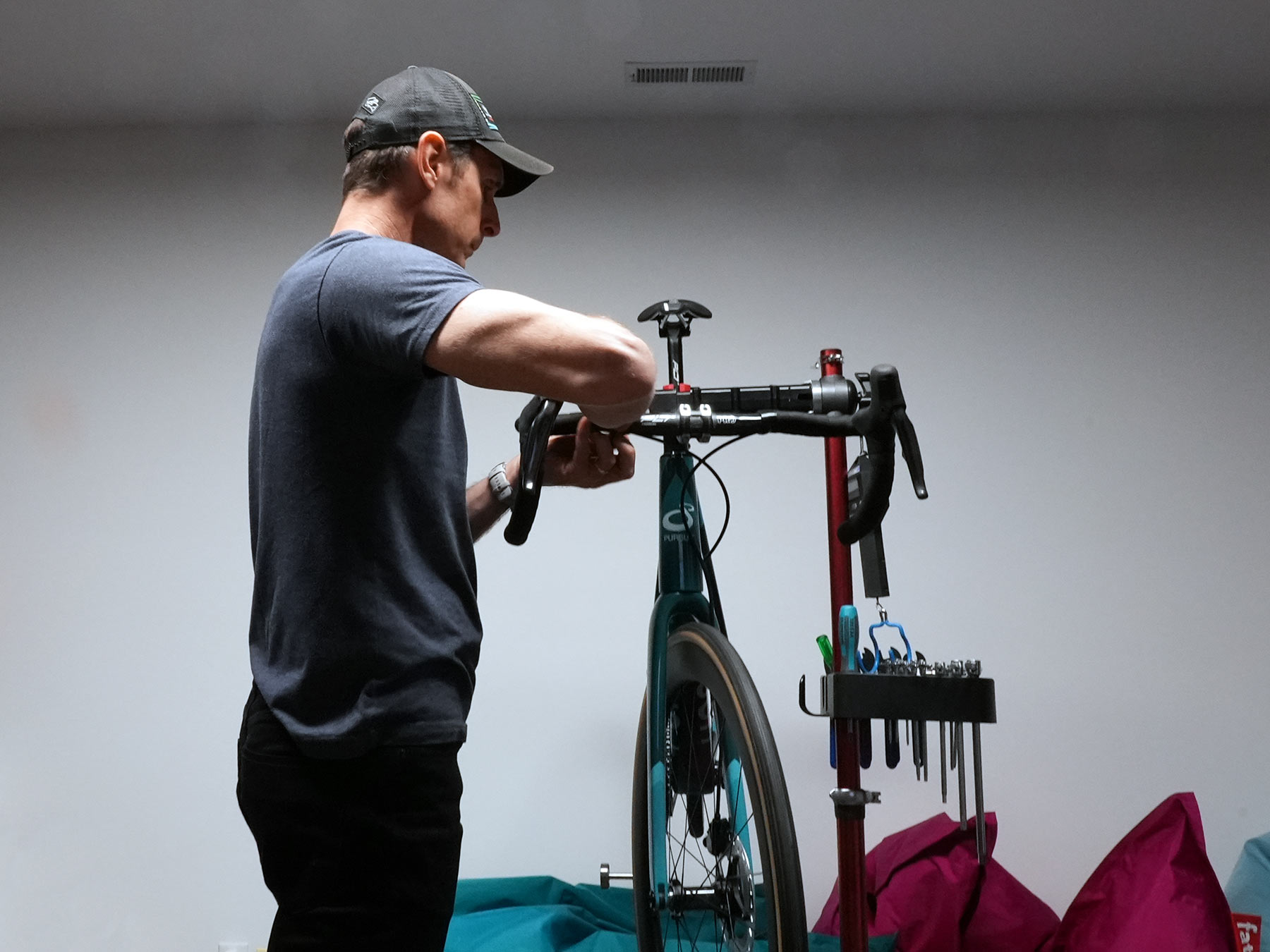
Turns out, we needed a 1-2mm (I forget which, exactly) spacer on the crank spindle on the driveside to push the chainrings out. That tiny amount of additional offset solved the problem. It’s something so simple, with no other warning signs to suggest it, that it eluded Shimano, Pursuit, and myself until we just tried it on a whim.
The point? Try the simple stuff first, and try to think of other solutions. Once the spacer was installed, shifting was perfect and has been for the 18+ months I’ve been riding the bike.
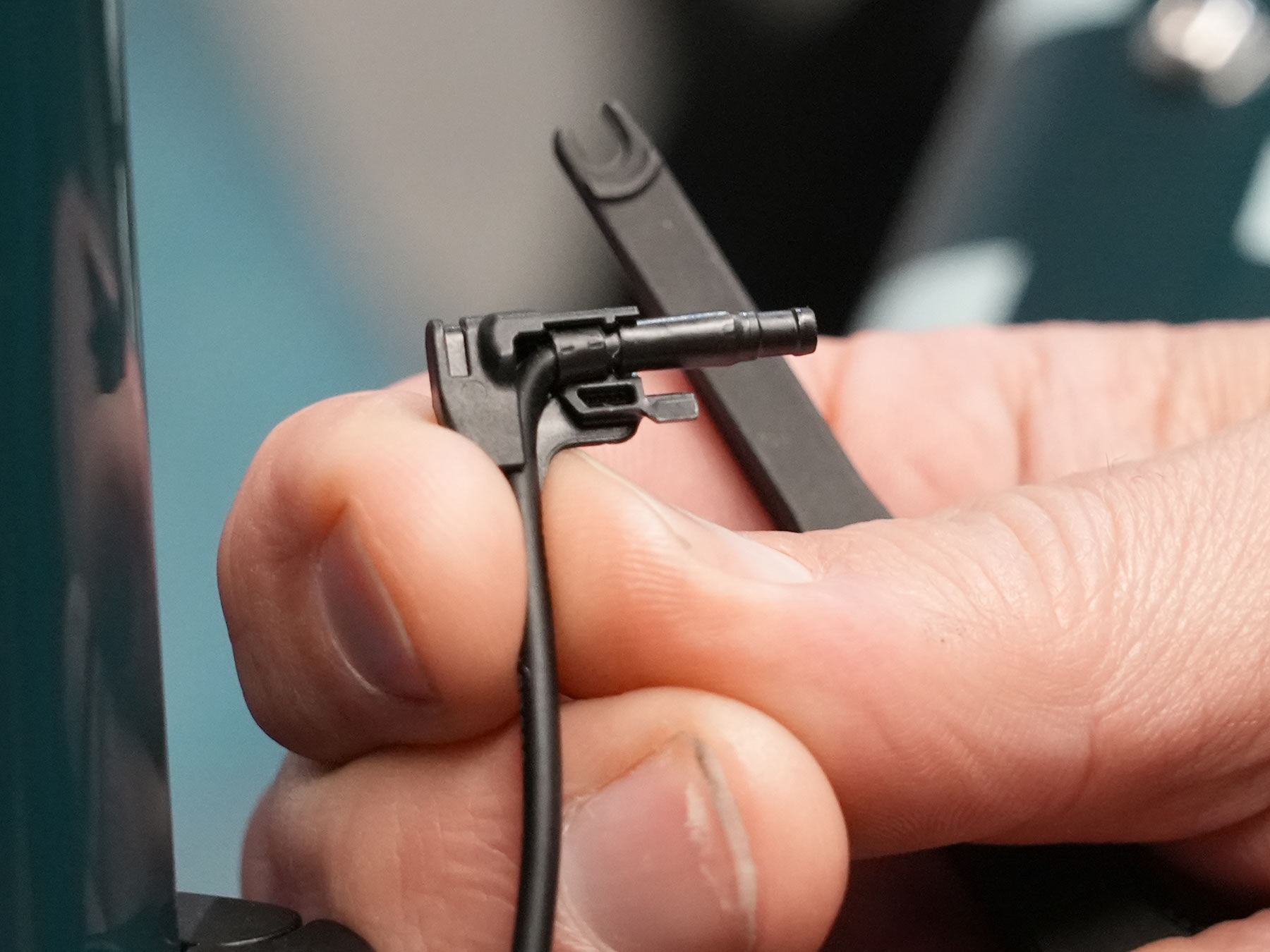
The front derailleur comes with a small wire guide that gives it a 90º angle while also protecting it from bending too sharply. This also keeps it from looping so wide it rubs your rear tire. It’s tiny and best installed with your rear wheel off the bike, trust me.
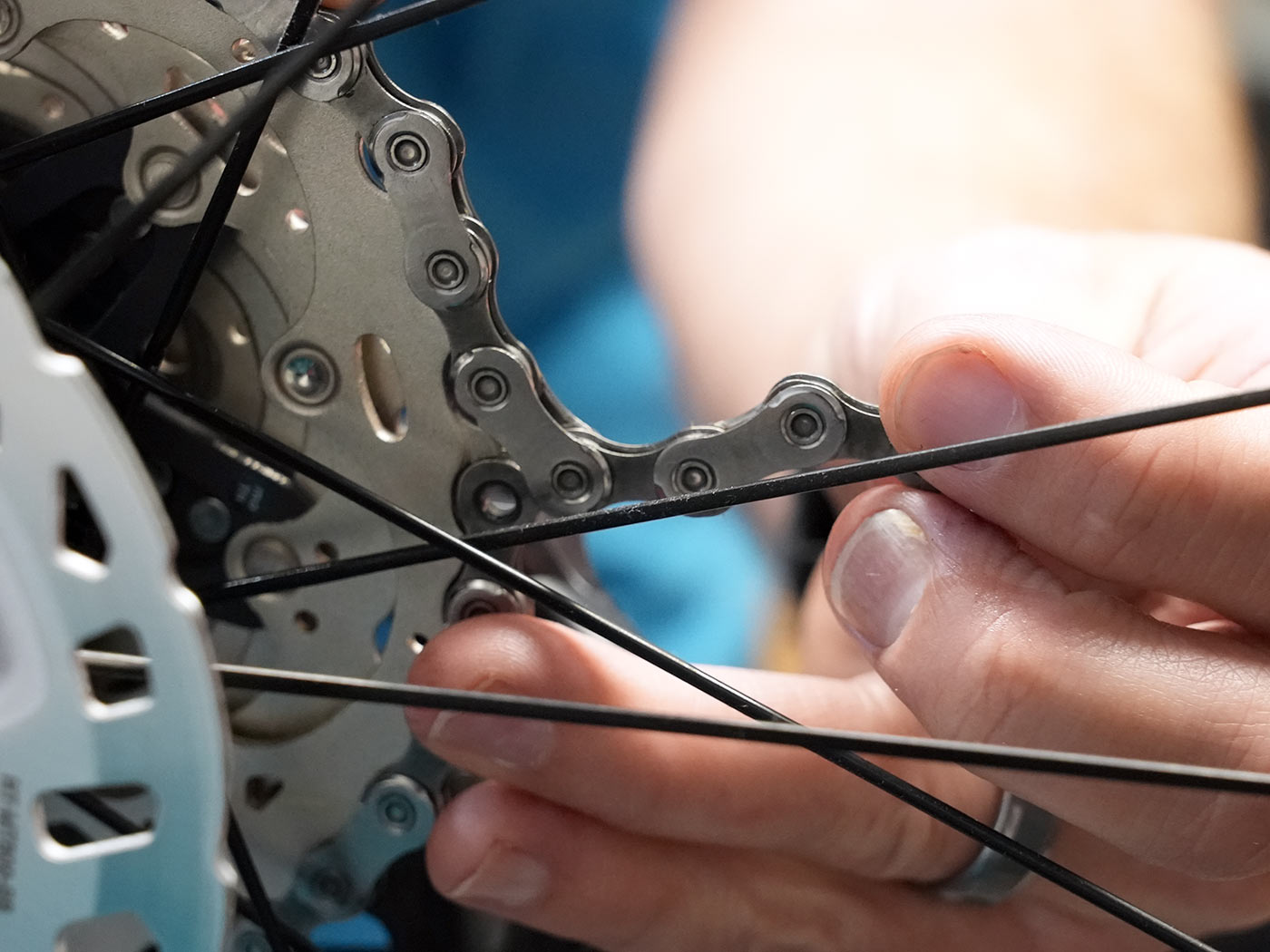
Shimano has easy guides for setting chain length…
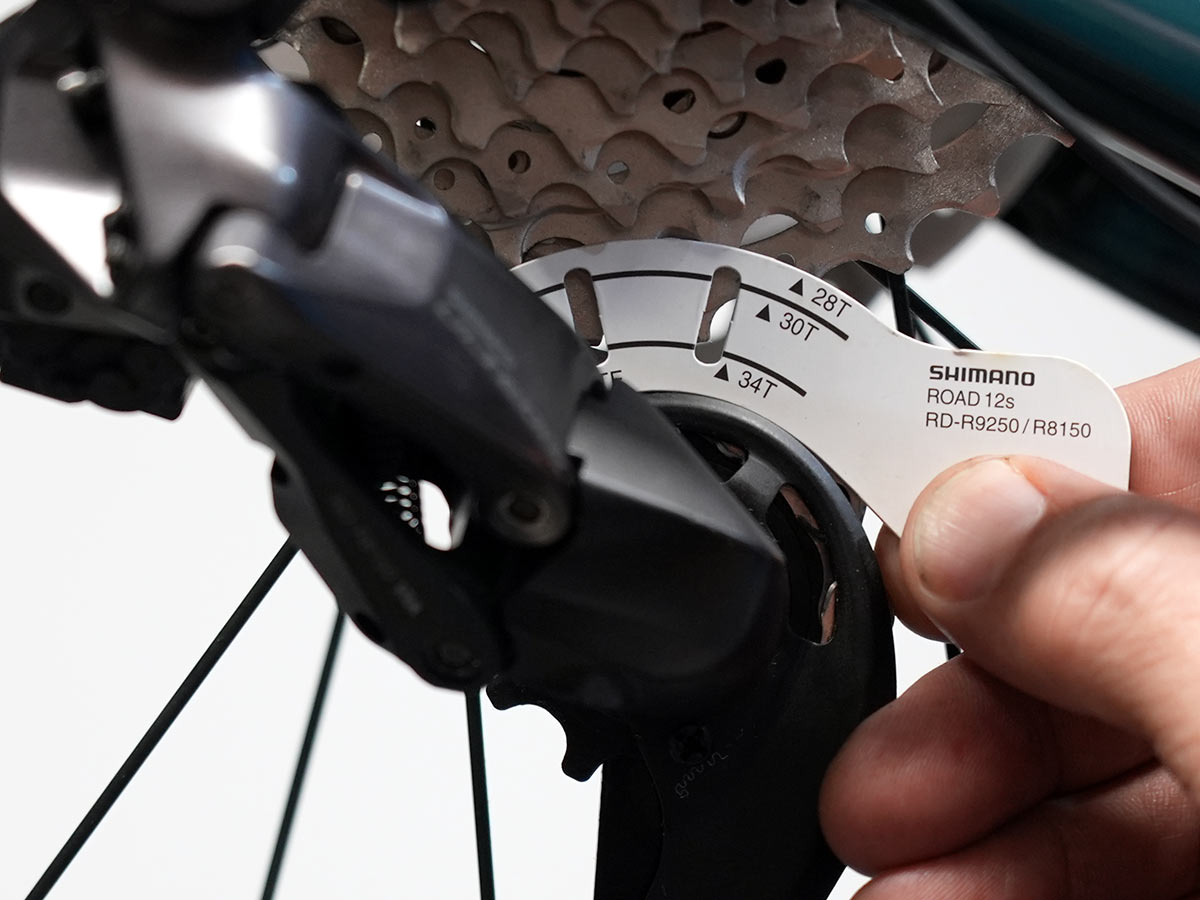
…and rear derailleur B-tension settings. The guide is plastic-free, which is nice, too.
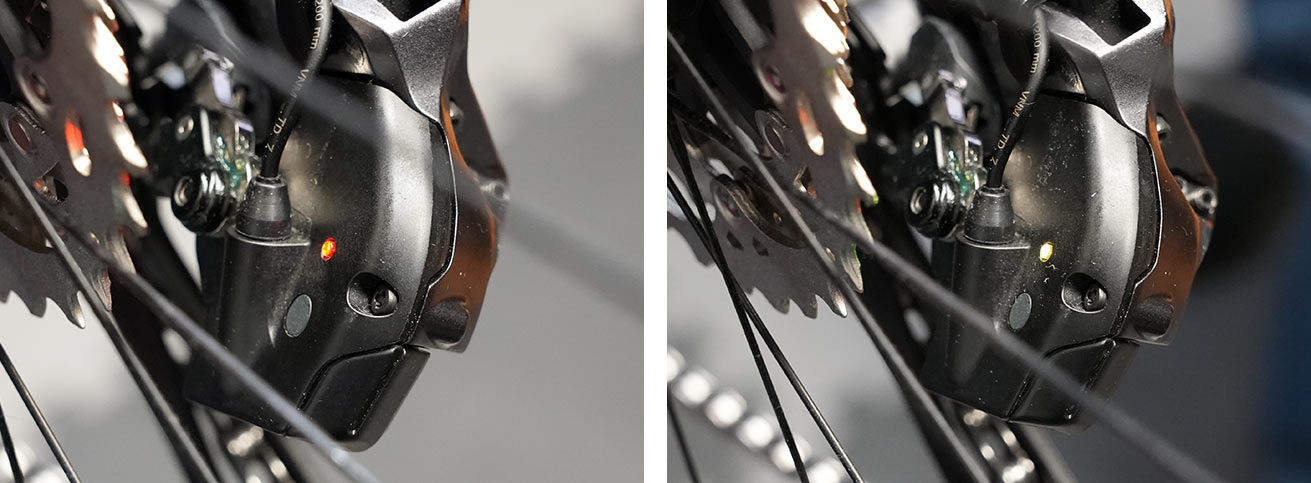
A small light is color-coded during setup so it’s easy to know if you’re in setup mode. It changes to blue while charging, then turns off when the battery is full.
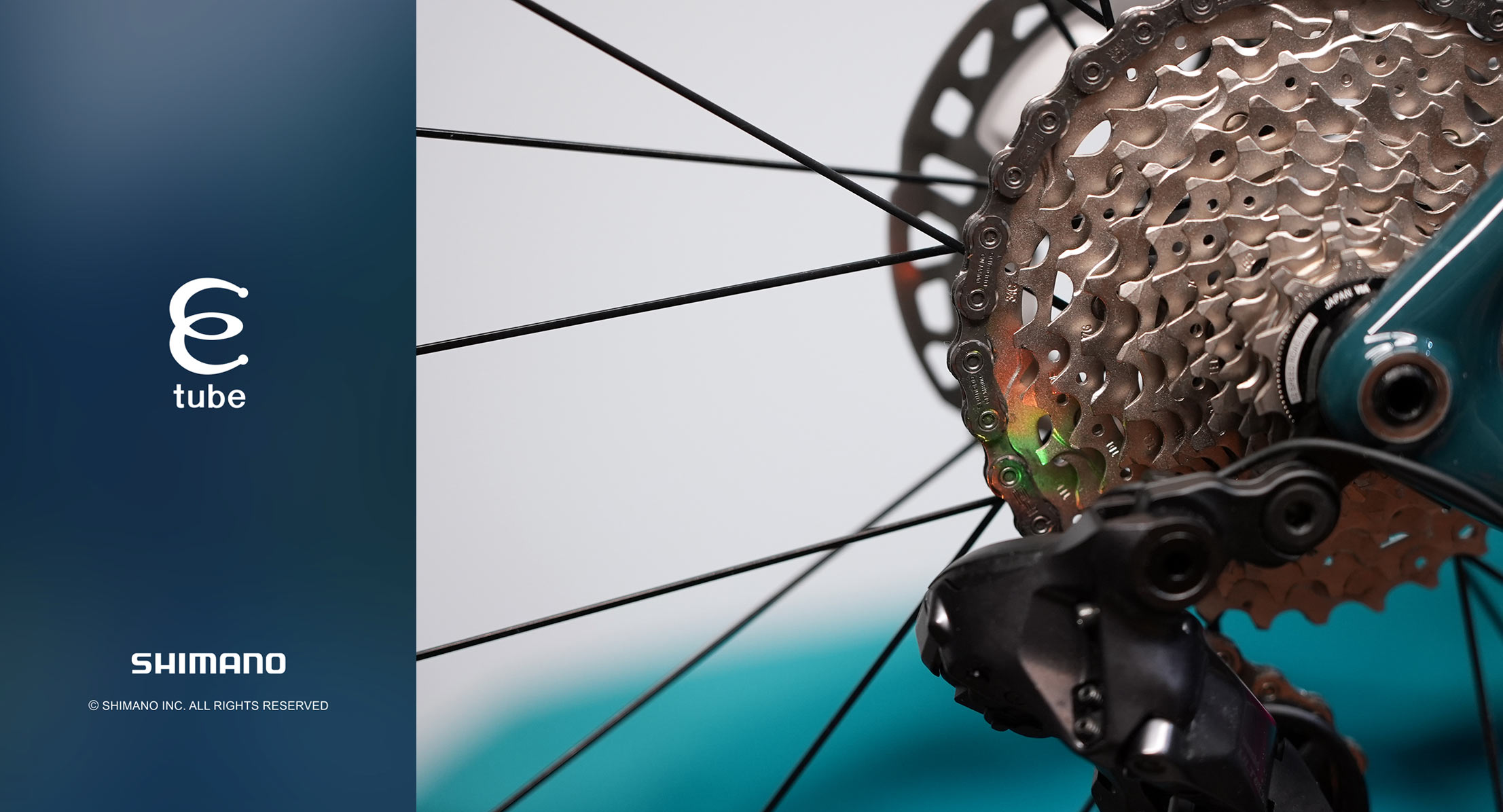
One of the biggest upgrades to the new Di2 12-speed is the ability to customize the shifting patterns, turn on Synchro Shift, and other features directly from their e-Tube app. Here’s a good video showing how to set it so you can put the rear derailleur into adjustment mode remotely from the shifters, allowing micro-adjusts while riding (not that you should need them, but it’s still cool).
Ultegra R8100 Ride Review
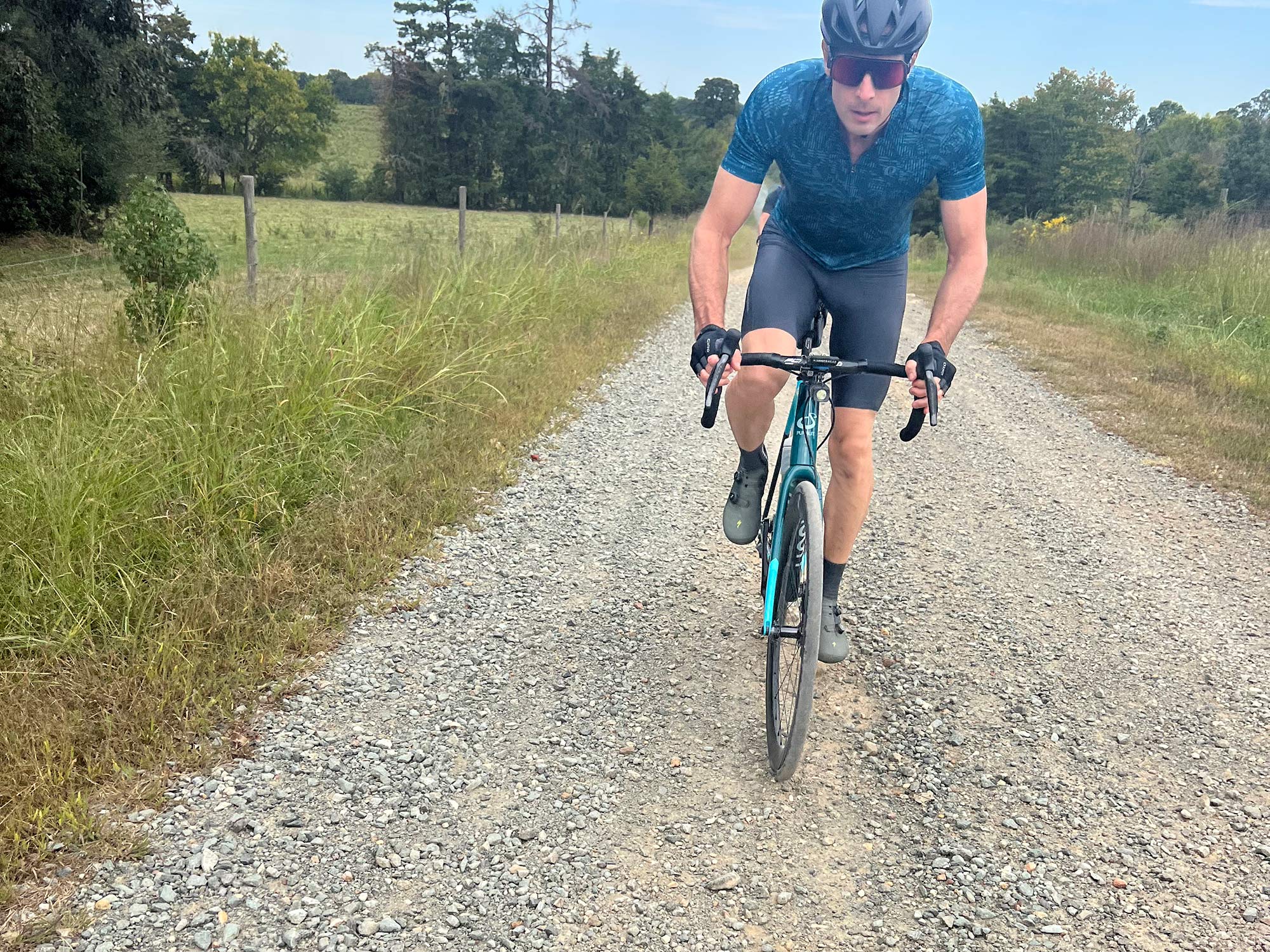
The nutshell version is this: I’ve ridden the new Dura-Ace 12-speed Di2 also, and Shimano’s Ultegra group performs every bit as well, but for a lot less money and only a few extra grams. If you’re building a bike or upgrading, it’s a great choice not only amongst Shimano’s drivetrains but a great choice in general.
Shifting is as quick as ever, to me feeling slightly faster than SRAM. It’s also very quiet, and feels smooth and effortless, even for an electronic group.
If you haven’t watched this video yet, please do, there’s a lot more to it than just speed…it also slightly overshifts every cog to ensure the chain gets where it needs to go, then trims back. It’s really cool!
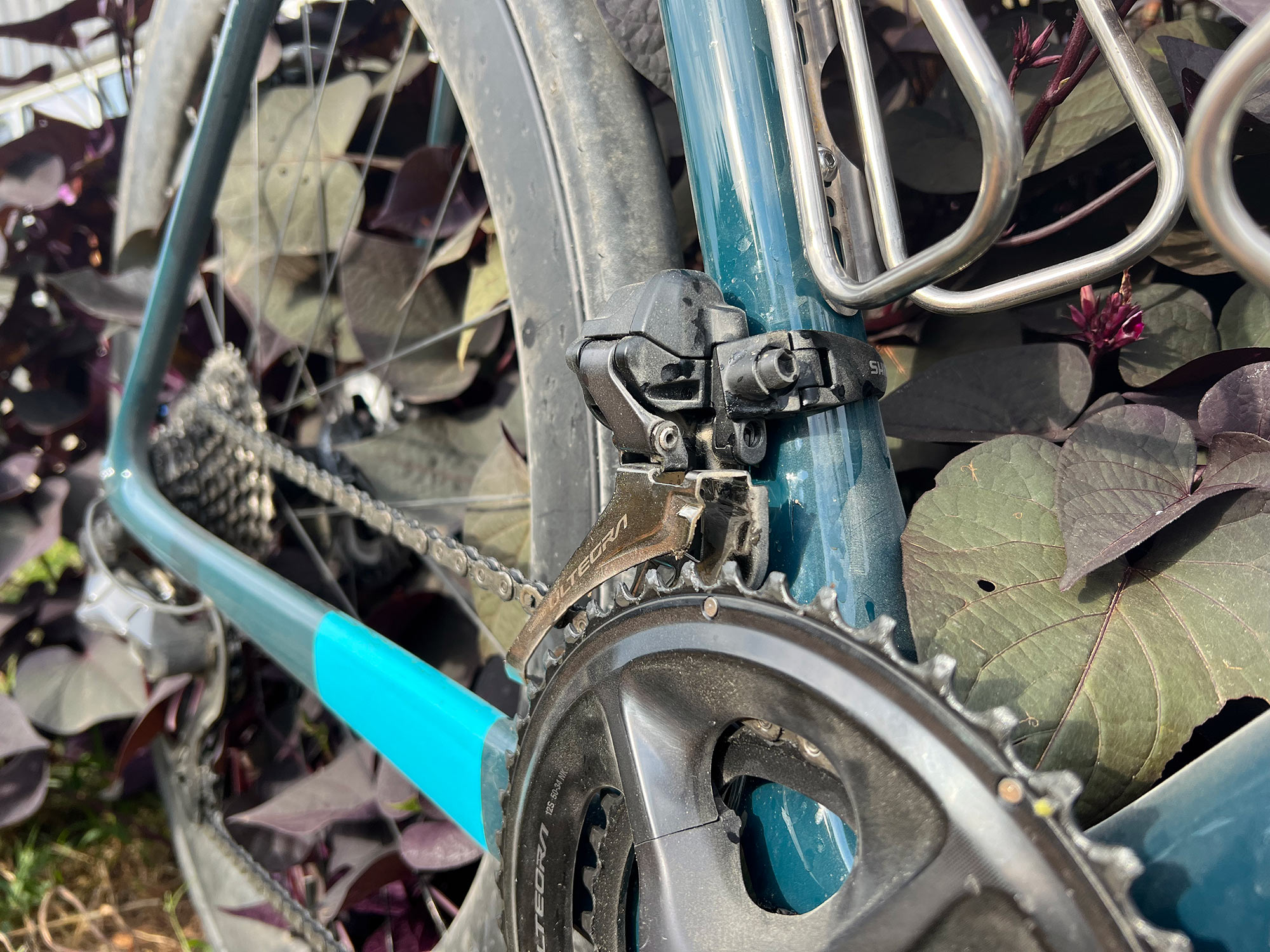
The front shifting is powerful and direct, as I expected. I’ve also owned Dura-Ace Di2 and GRX Di2 11-speed groups, and the new 12-speed front shifting seems slightly smoother.
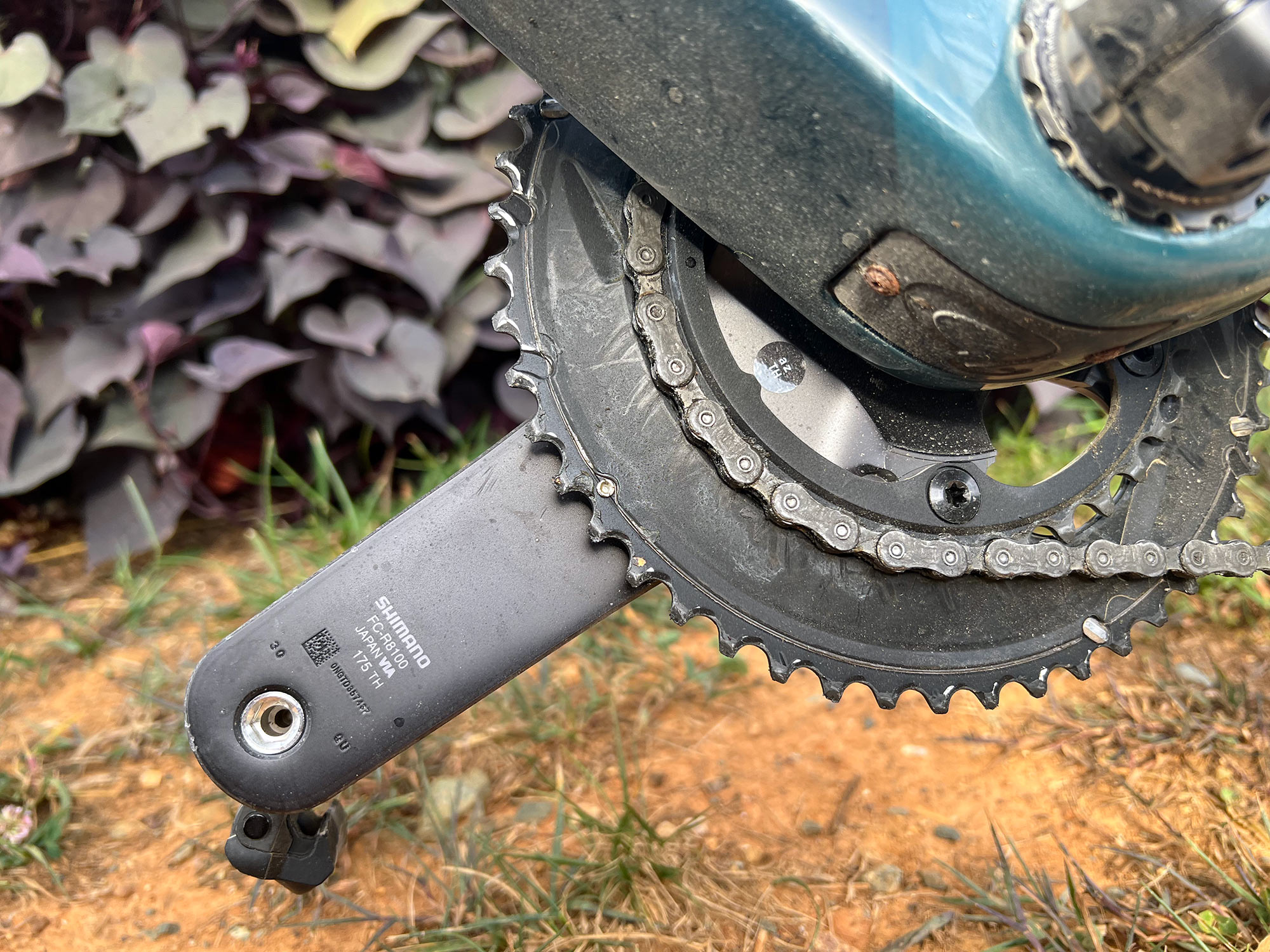
SIDEBAR: I can’t review this group without talking about Shimano’s 11-speed crankarm recall. The 12-speed cranks are made using the same hollow forged and bonded construction, so I asked Shimano what changed with these new ones to prevent them from having the same problem. Their response was:
“Shimano has made numerous changes, improvements, and enhancements in response to the market information we received. This is standard practice at Shimano.“
…which is about what I expected. I’d love a more technical explanation, but they’re very secretive about their processes. I got a look at that process during my factory tour for the XTR launch if you’d like to see it. FWIW, they’re not the only brand using this construction method, and I haven’t had any problems with these (or my prior DA) cranks.

The rear derailleur is interesting. There’s no clutch or spring damping for the pulley cage, and the spring tension is very light. I applaud having derailleurs that can cover everything from road to rough gravel, but I also appreciate a part that’s purpose built to excel at one thing. I believe this is what allows Shimano’s shifting to feel so light and fast, which is especially noticeable on their mechanical groups.
This is allows the chain to bounce, but not how you might think. As the two action shots (and dust) suggest, a lot of my road rides end up on stretches of gravel, sometimes with lots of stutter bumps and potholes. Despite these mini adventures, I never noticed that lack of chain management and never dropped a chain.
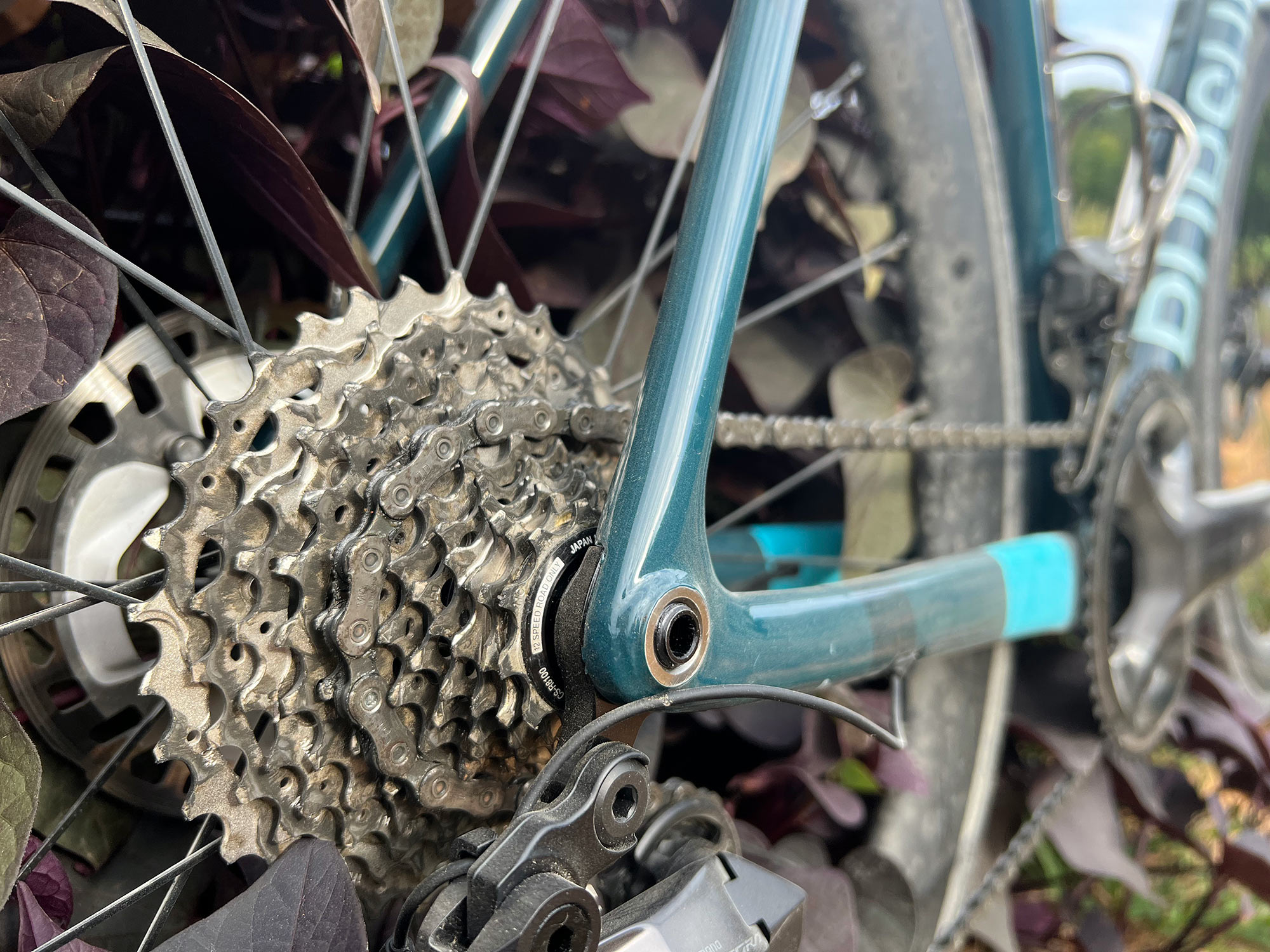
Where I notice it is when I backpedal quickly, particularly in the small chainring. I do this to adjust crankarm position for a corner, or shuffle around on my saddle. A quick, exaggerated backpedal often yanks the pulley cage forward, creating a big swoop of chain slack, followed by a rapid retraction. It feels weird, a little disconcerting, and is diminished by increasing B-screw tension.
I considered shortening the chain slightly, but the setup is dialed according to spec and a shorter chain would likely cause issues getting into the largest cogs from the big chainring (I know, you don’t have to say it, but we all do it). Ultimately, it hasn’t affected performance, but I wanted to mention it.
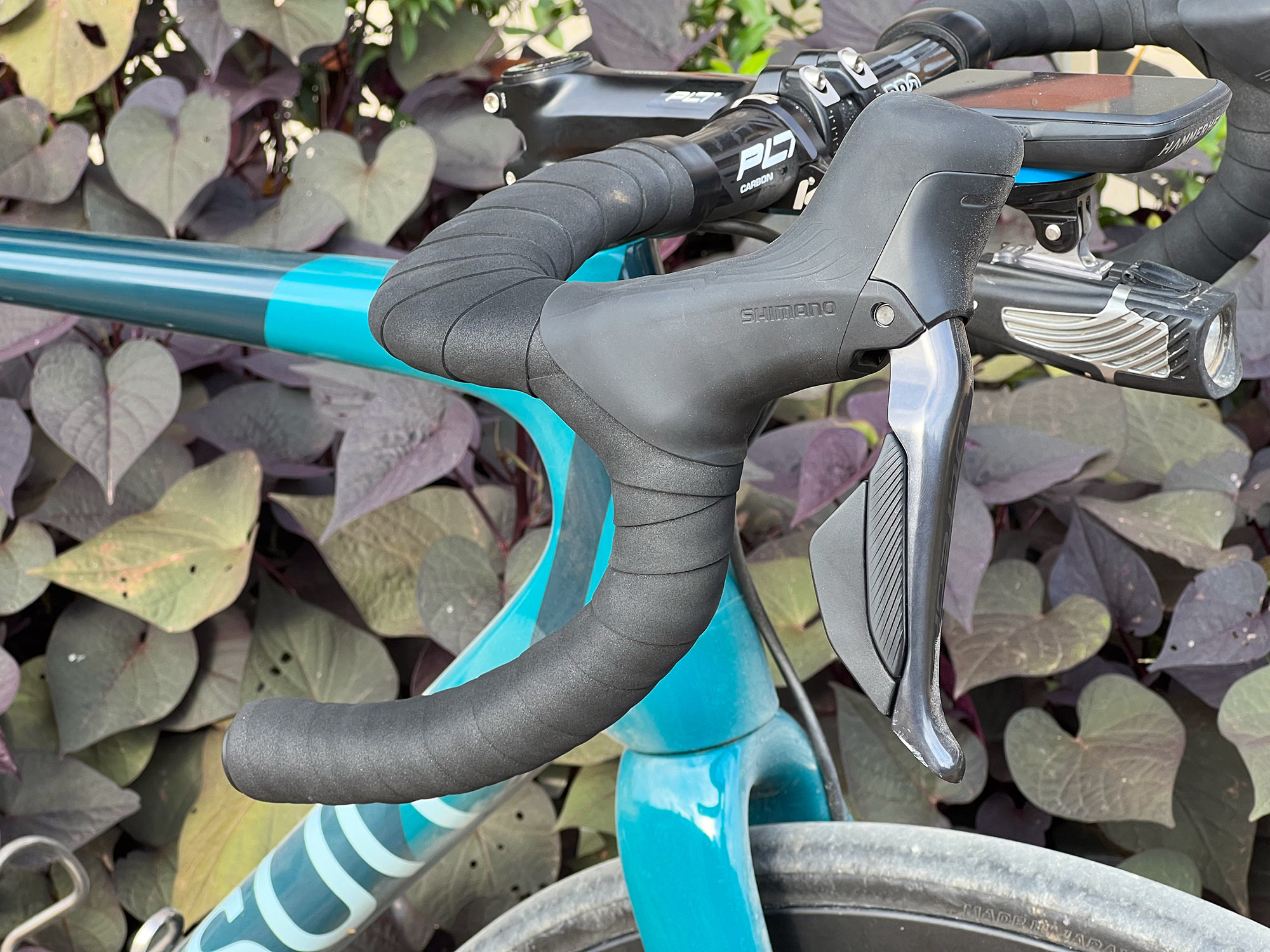
Hood shapes are great, with nice ridges on top for grip. The pronounced bump at the front is reassuring on spirited climbs, and finger clearance is adequate when braking from the hoods.
The larger shift paddles are easy to use, and the differing textures make them easy to identify even with full finger gloves. The wireless design is nice, decluttering the cockpit, and shifting is as fast as ever…I couldn’t tell any difference between reaction speed from prior wired versions.
The charging port is on the rear derailleur, which is a big upgrade from the tiny junction port and having to wire it somewhere. It’s still a single wire to charge the group, which is convenient, though you’ll need to put your bike near an outlet.
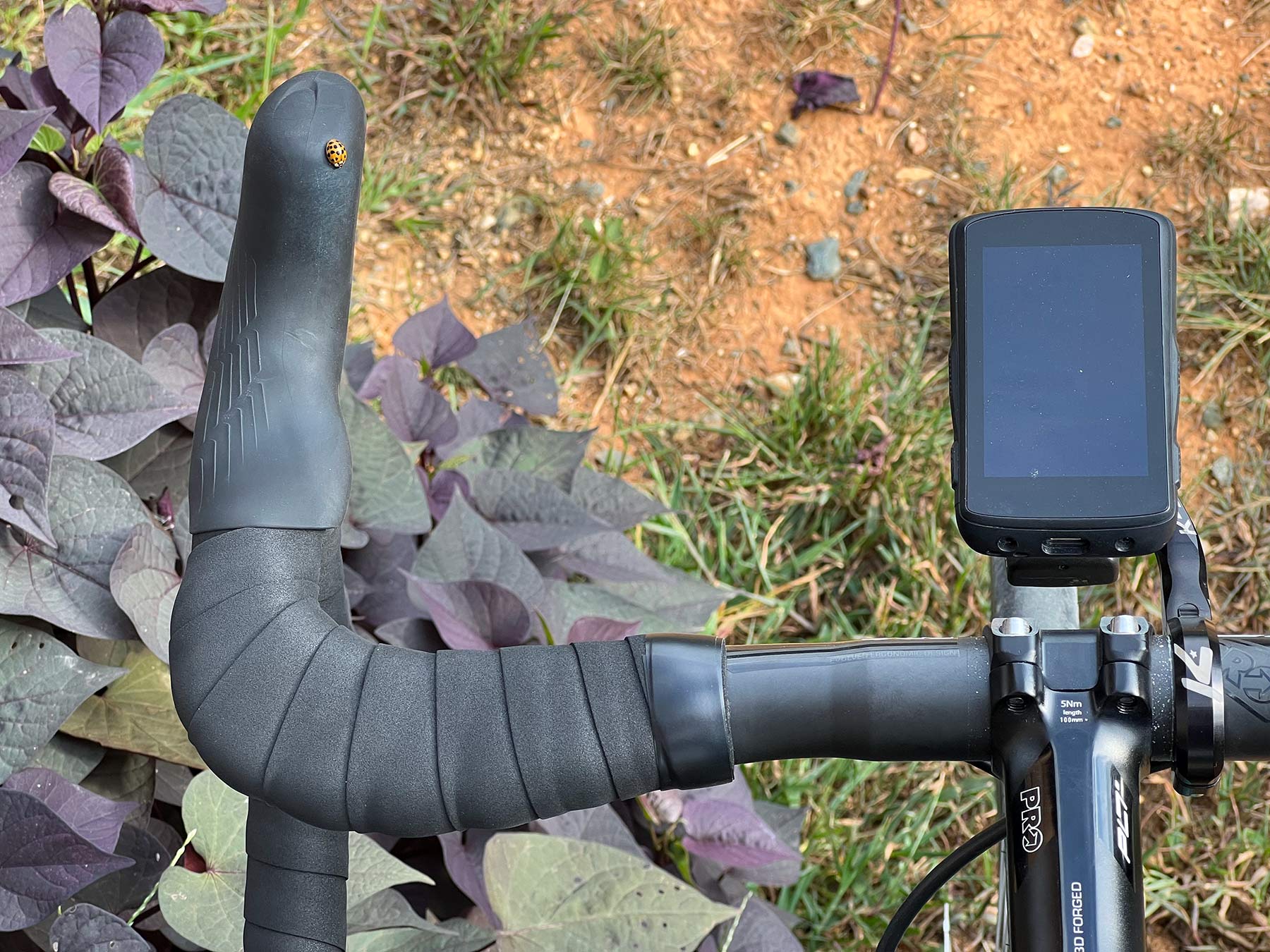
SIDEBAR: Shimano often sends review groups with a full PRO cockpit, and their PRO PLT Ergo Carbon Handlebar deserves a shout-out. It has an exceptionally good shape. The flattened tops get deeper at the corners where my hands often rest, creating a huge platform for my palms. It’s stiffer than most carbon bars I’ve ridden, so it transmits a bit more vibration, but I plan on swapping to a gel-backed bar tape to mitigate that because its ergonomics are worth keeping.
The PLT stem is also great, with surprisingly good torsional stiffness for its girth and faceplate width. Both are reasonably light and a perfect example of Shimano’s understated excellence.
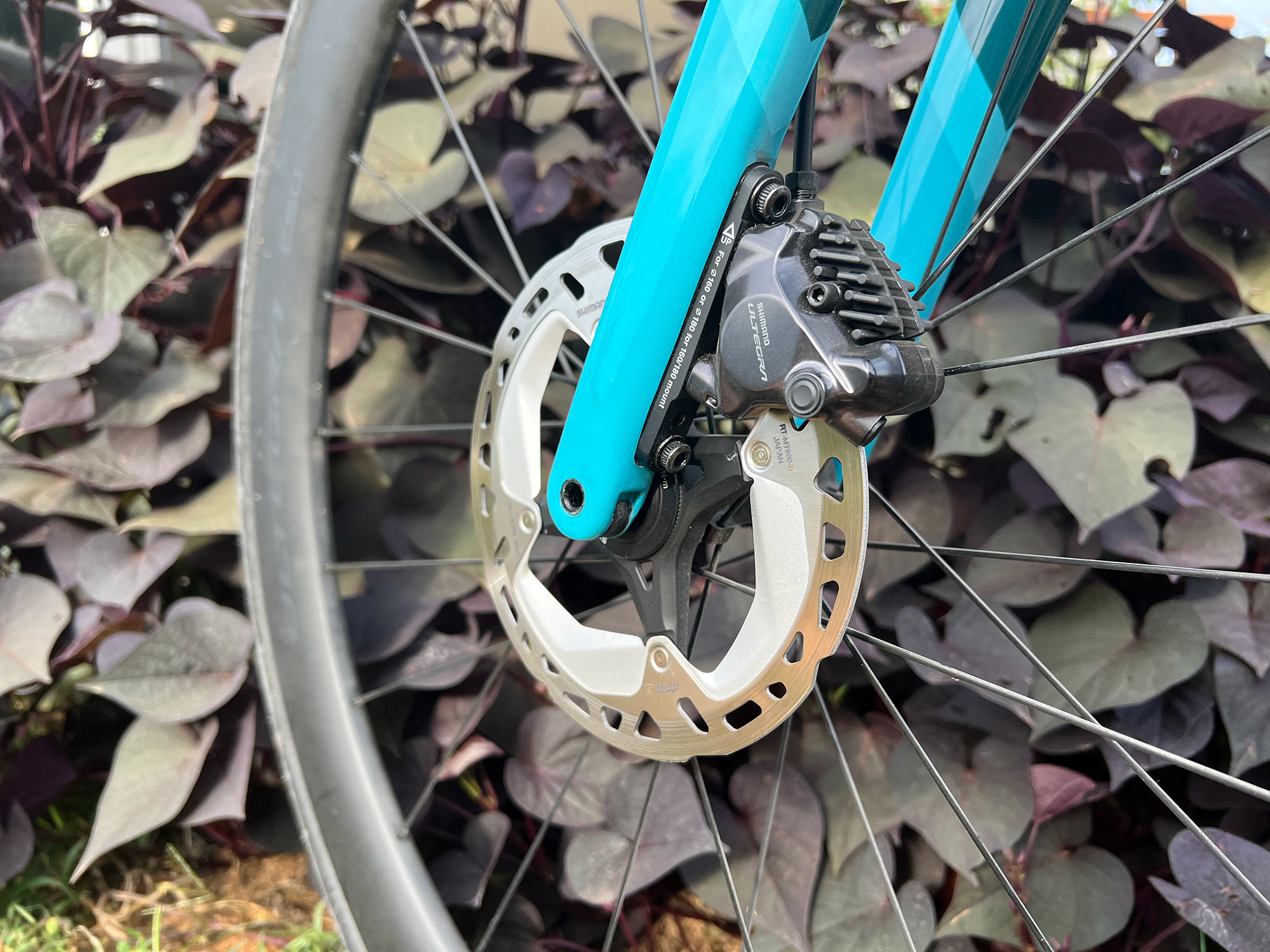
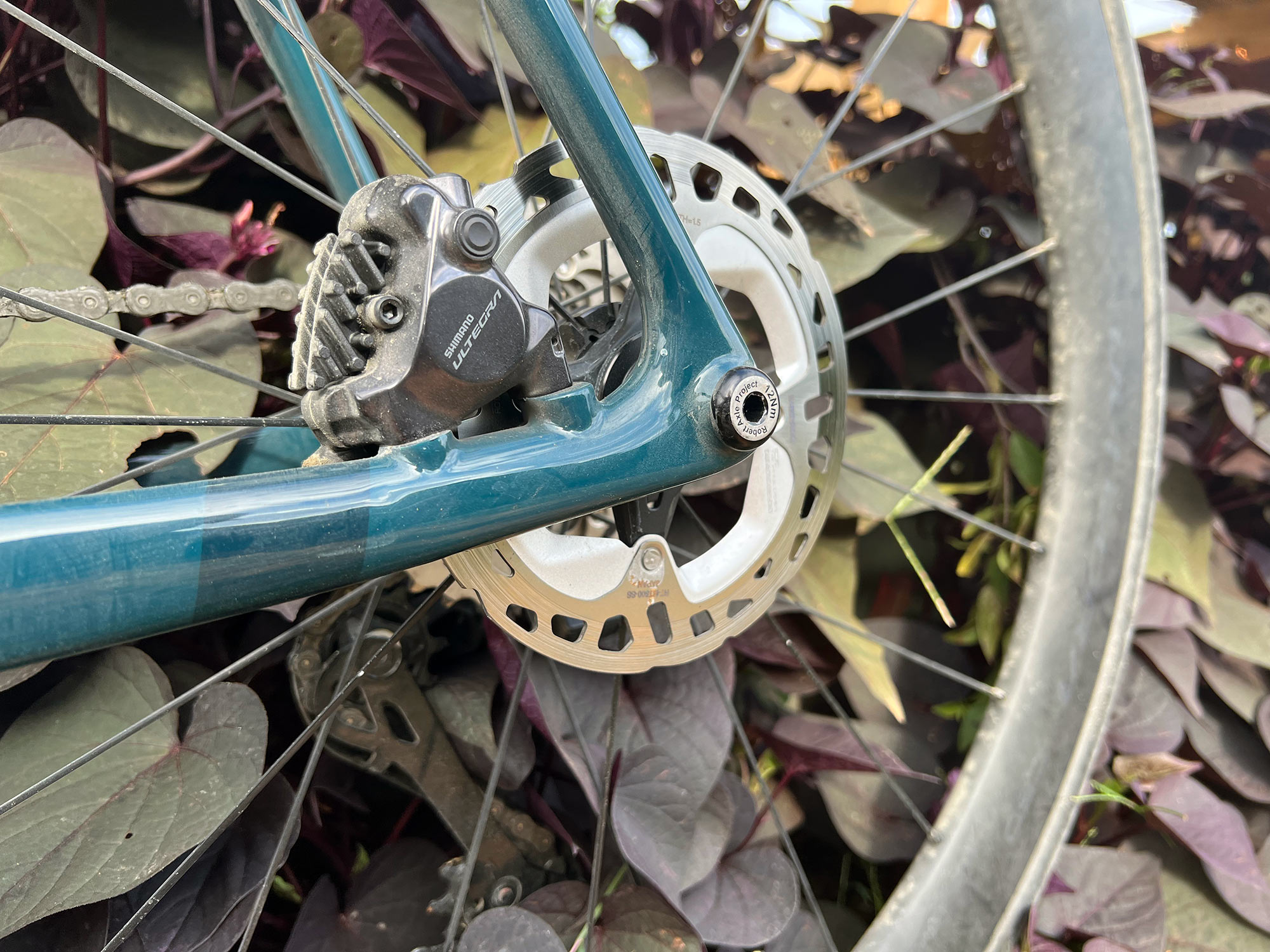
When Shimano first introduced their road disc brakes, they made it clear they were powerful and cool enough to run 140mm rotors, while others were suggesting 160mm as a minimum.
For me, I went with 160m in the front, 140mm in the rear. It’s a good mix, and I like the extra modulation the larger rotor provides. Shimano’s brakes are smooth, with the right amount of bite from their Servo Wave lever leading into well-controlled progression.
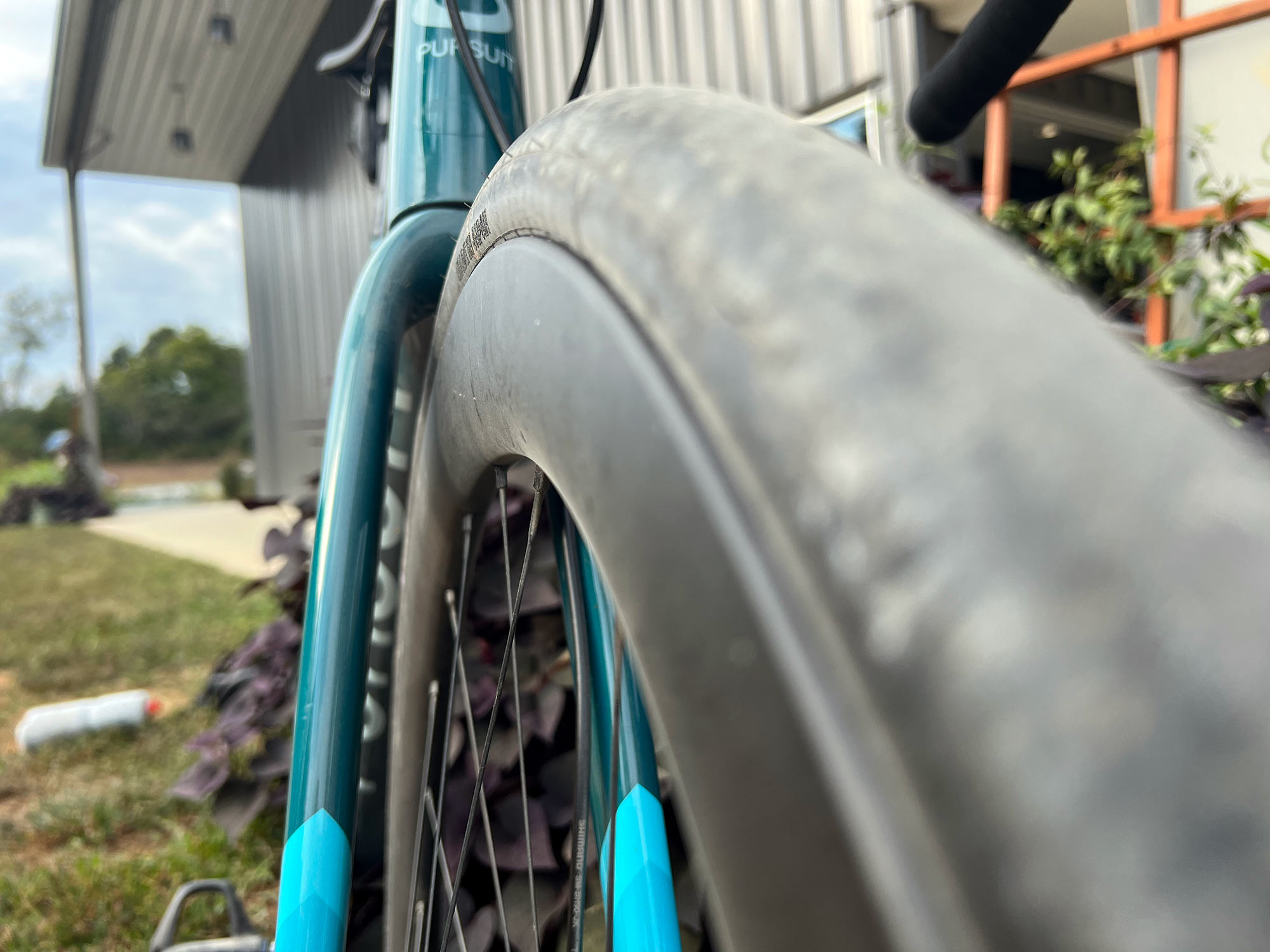
Perhaps the least talked about part of the group are the Ultegra WH-R8170-C50-TL wheels, and I blame Shimano. They simply don’t hype them enough, but they’re really good. They’re aero without making a bunch of aero claims, and Ultegra shares the same rim profile as the Dura-Ace wheels.
They roll very smoothly thanks to cup-and-cone bearings. The 21mm internal width rims held everything from 28mm to 36mm-ish tires with easy tubeless setup. And they’re reasonably light (628g front, 872g rear, 1500g total) for the C50 model (50mm deep rims, also available in 36mm and 60mm depths).
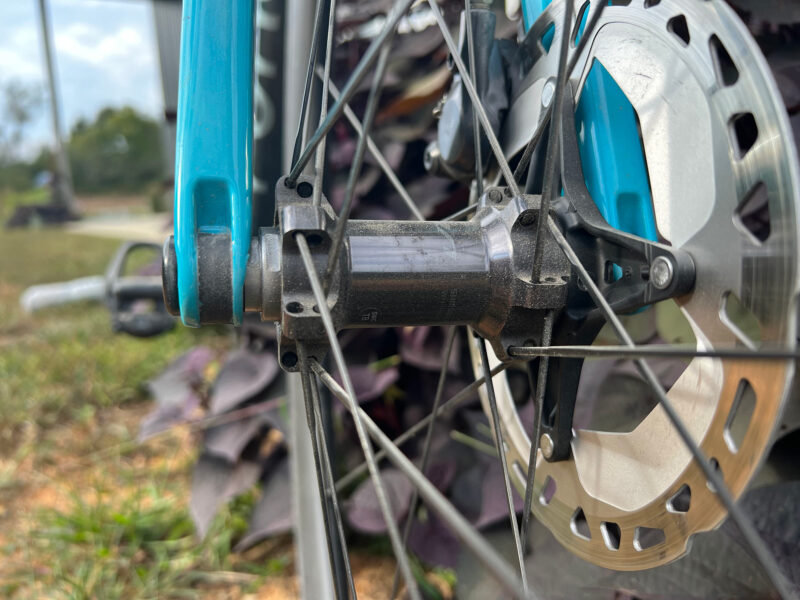
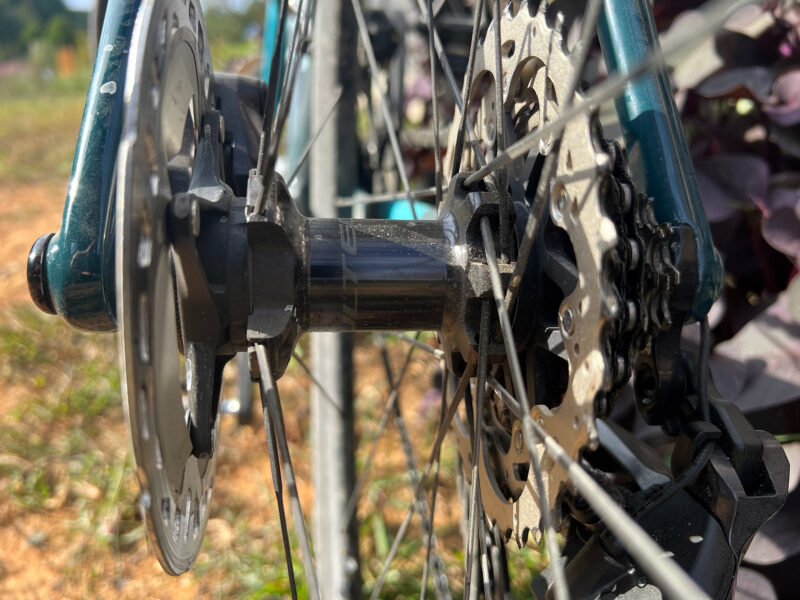
The hubs have a gray anodizing to match the rest of the group and come with a standard HG freehub body.
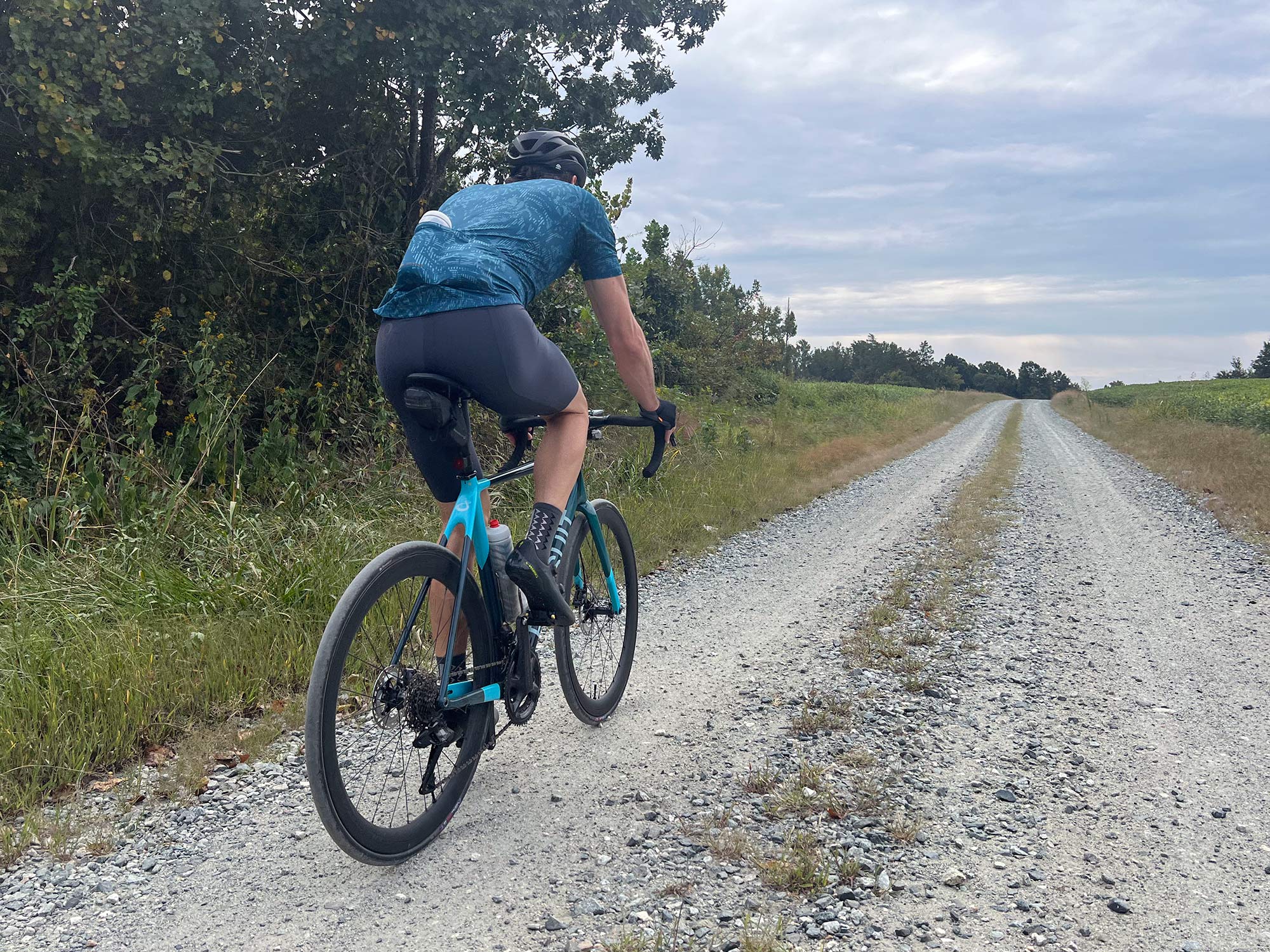
For high performance road riding, Ultegra Di2 12-speed leaves nothing to be desired. Shifting is precise and fast. Hood and lever ergonomics are great. It’s light, and the understated dark gray ano looks great on any bike, perhaps even better than the glossy black of Dura-Ace.
It even works well on “alt roads”, and the rims held up to low tire pressures on gravel roads, too. If you’re in the market for top-tier performance without the top-tier price, Ultegra R8100 delivers.
Read our launch coverage here for all of the tech details on this and Dura-Ace.
